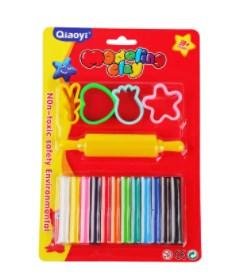Hobby craft plasticine, a malleable and versatile modeling material, has become a staple in the world of arts and crafts, particularly for children's education and creative play. While it provides endless hours of fun and learning, it is essential to consider the environmental impact of such products. This article will examine the potential environmental effects of hobby craft plasticine and discuss the measures that can be taken to minimize its ecological footprint.
The production of hobby craft plasticine involves the use of various materials, including plastic polymers, which are derived from petroleum. The extraction and processing of these materials can contribute to environmental issues such as habitat destruction, pollution, and climate change. Additionally, the use of non-biodegradable materials in plasticine can lead to waste problems, as the material does not decompose easily in the environment.
However, manufacturers of hobby craft plasticine are increasingly aware of these concerns and are taking steps to implement more sustainable practices. One such measure is the use of biodegradable or eco-friendly materials in the production of plasticine. By incorporating natural ingredients and reducing the reliance on petroleum-based products, the environmental impact of hobby craft plasticine can be significantly reduced.
Another important aspect is the promotion of proper disposal and recycling practices among consumers. Encouraging users to recycle hobby craft plasticine packaging and to dispose of used plasticine responsibly can help minimize the material's contribution to landfill waste. Some manufacturers are also exploring the possibility of creating recycling programs specifically for their plasticine products, allowing users to return used material to be reprocessed and reused.
Education plays a crucial role in promoting environmental awareness and responsible behavior. Manufacturers and retailers of hobby craft plasticine can contribute by providing information on the environmental impact of their products and offering guidance on sustainable use and disposal. This can include clear labeling of products with environmental information, as well as educational materials that explain the importance of eco-friendly practices.
Moreover, the development of innovative packaging solutions is another area where the industry can make a difference. Using recyclable or compostable packaging materials, reducing packaging to a minimum, and avoiding the use of harmful additives are all steps that can be taken to make hobby craft plasticine more environmentally friendly.
It is also worth noting that hobby craft plasticine, due to its non-toxic nature, can be a more environmentally friendly alternative to other modeling materials that may contain harmful chemicals. This makes it a preferred choice for parents and educators who are conscious of the materials they introduce to children.
In conclusion, while hobby craft plasticine does have an environmental impact, numerous measures can be taken to mitigate this effect. By using eco-friendly materials, promoting responsible disposal and recycling, providing educational resources, and developing sustainable packaging solutions, the industry can work towards a more environmentally conscious future. It is the collective responsibility of manufacturers, retailers, and consumers to ensure that the joy of creative play with hobby craft plasticine is balanced with a commitment to protecting our planet for future generations.

